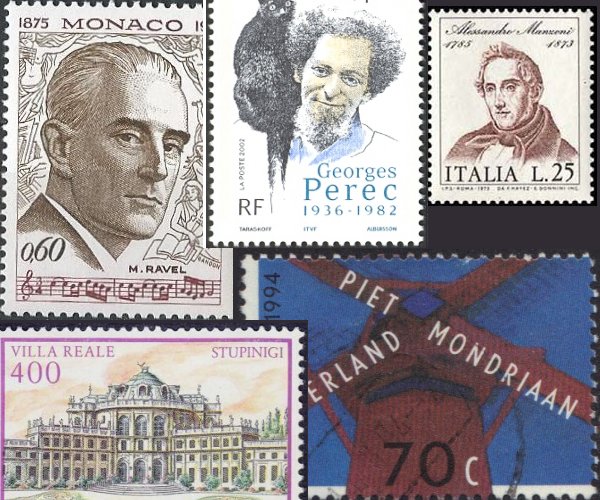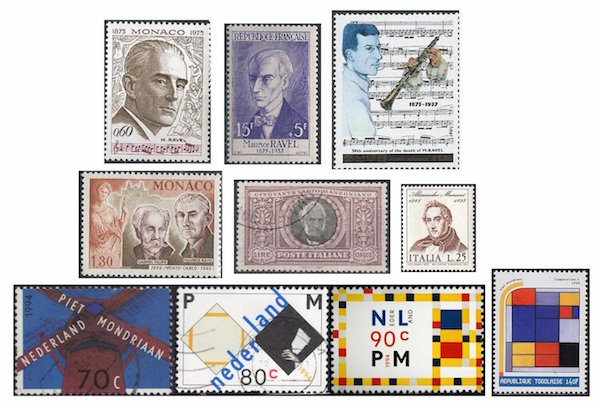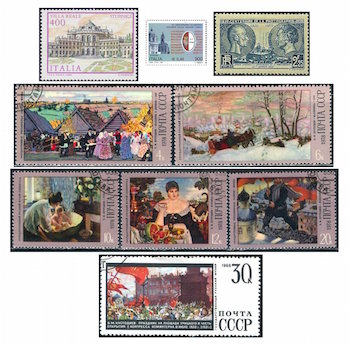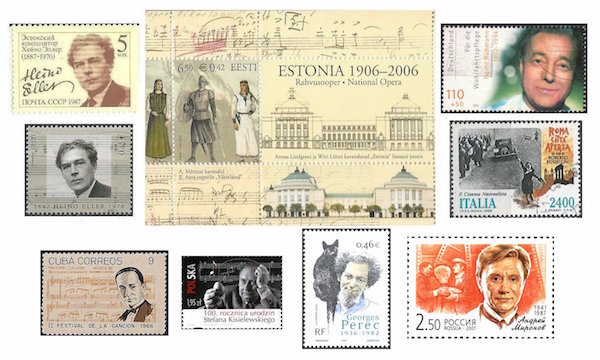The Arts on the Stamps of the World — March 7
An Arts Fuse regular feature: the arts on stamps of the world.

By Doug Briscoe
March 7 is the birthday of Maurice Ravel, Alessandro Manzoni, and Piet Mondrian. In addition, we salute the inventor of photography, Nicéphore Niépce, two (two!) Estonian composers, Heino Eller and Evald Aav, and more.
In the 1920s and 30s, Maurice Ravel (7 March 1875 – 28 December 1937) was commonly held to be the greatest living French composer, and who am I to argue with the common-holders? I can’t resist listing the Ravel scores I personally love best: the String Quartet, the Introduction and Allegro, Ma Mère l’Oye, Daphnis and Chloë, Le Tombeau de Couperin. The first Ravel stamp was issued, appropriately, by France in 1956; ten years later, Monaco issued the one honoring both Ravel and Fauré and followed that with a 1975 issue for Ravel alone (I patiently figured out that the music is the Boléro theme); 1987 saw the release of a North Korean (!) stamp marking the fiftieth anniversary of the composer’s death (Boléro again).
Alessandro Manzoni (1785 – 22 May 1873) was the author of a book regarded as one of the great masterpieces of world literature, The Betrothed (I promessi sposi). Manzoni was born in Milan, and his mother and grandfather were writers, but little Alessandro did so poorly in school that he was dismissed as a blockhead, until, that is, he wrote two impressive sonnets at the age of fifteen. His religious life was something of a roller-coaster—from anticlerical Voltairianism to marriage to a Calvinist who converted to Catholicism and whose piety turned Manzoni to a rather strict religiosity. He wrote sacred lyrics at this time before producing his first play, which was admired by Goethe, in 1819. His chef d’œuvre was completed in 1823, though he returned to the text for revisions until the final version appeared in 1842. His death from complications from a fall led to the creation of Verdi’s Requiem. I promessi sposi itself was made into operas by Ponchielli (1856) and Errico Petrella (1869) and has been translated to the screen (silver and television) on a number of occasions. A set of stamps honoring Manzoni came out in 1923, and another single issue appeared fifty years later. Incidentally, the higher denominations of the 1923 set fetch a pretty penny—the one shown here is being offered online at an asking price of $440, a good deal, since the book value is ten times that. In this case, the canceled stamps are worth much more than the mint ones, which suggests that many people bought these as keepsakes, never intending to use them for postage.

One of the titans of modern art, Pieter Cornelis “Piet” Mondriaan, was born on this day in 1872. (On moving to Paris in 1911 he altered the spelling of his name by dropping one of the As.) His father was a teacher one of whose topics was drawing, and Piet took to painting at an early age, eventually becoming a teacher himself. Two movements that sharply influenced Mondrian’s work, one philosophical, the other artistic, were theosophy and Cubism. Restricted throughout World War I to his native Netherlands, where in 1917 the movement he joined known as De Stijl was founded, Mondrian returned to France in 1918 and remained there until the next war threatened, whereupon he went to London and New York, dying in the latter city on 1 February 1944. A Dutch set of three stamps from 1994 shows, in sequence, a detail from The Red Mill (1910-11), Rhomboid (or Lozenge Composition) with Four Yellow Lines (1933), and a detail from Broadway Boogie Woogie (1942-3). Composition A of 1920 is represented on a Togolese stamp I can’t otherwise identify.
Italian architect Filippo Juvarra (1678 – 31 January 1736), though born in Messina, was responsible for a number of churches and villas in and around Turin. One of his buildings was the Palace of Stupinigi (1729-31), a royal hunting lodge situated some six miles outside the city. Another, perhaps his masterpiece, was the basilica Superga that sits atop a mountain overlooking the metropolis. On our first stamp the palace can be seen clearly enough, but the tiny image I have for the basilica merely hints at the beauty of the structure, which can be much better seen here. Juvarra’s early days in Sicily saw him designing festivities for the coronation of Philip V. He moved on to Rome to study architecture but was still for a time more involved with overseeing ceremonies, celebrations, and set designs for the stage. His patron, Cardinal Ottoboni, wrote a libretto for an opera by Carlo Francesco Pollarolli (c.1653–1723), and this gave Juvarra his first occasion (1709) to design all the sets for an opera. His first significant architectural project was a chapel in the church of San Girolamo della Carità. Besides his work in Turin, he went on to build palaces in Madrid and was also an engraver, having put out a book of sculpted coats-of-arms in 1711.
Nicéphore (born Joseph) Niépce (1765 – 5 July 1833) made the earliest surviving true photograph in 1826 or 1827, a view looking out his window. (He had made some rudimentary heliographs in the years leading up to this.) So we honor this brilliant inventor with a French stamp of 1939 that pairs with him with another pioneer of photography, Louis Daguerre.

Boris Mikhaylovich Kustodiev (7 March [O.S. 23 February] 1878 – 28 May 1927) was a painter and, like Filippo Juvarra, a stage designer. He was born and grew up in Astrakhan, where his father was a professor at the local seminary. Kustodiev studied art there and in the studio of the great painter Ilya Repin in St. Petersburg. His first exhibition was held in 1896. In 1904 he was in France and Spain on a grant from the Imperial Academy of Arts, and in the following year he began to interest himself with book illustration, which occupied him all the rest of his life. His work in the theater centered on productions of plays by Alexander Ostrovsky. A lovely 1978 set of stamps from the Soviet Union brings us five of his paintings: Village Holiday (1910), Shrovetide (1916), Morning (also 1910), The Merchant’s Wife, which he painted in 1918 after becoming a paraplegic from tuberculosis of the spine, and Bolshevik (1920). An earlier stamp issue from 1968 shows us his Celebration on Uristsky Square (1920).
Heino Eller (1887 – 16 June 1970) is one of the composers I learned of from Neeme Järvi’s two volumes of Music from Estonia on Chandos LPs issued in 1986-7. A composition teacher, Eller was the center of the Tartu school of composition that developed in the 1920s and 30s, the most prominent adherent of the school being Eduard Tubin. (The school’s rival was the so-called Tallinn school headed by Artur Kapp, whose birthday we noted just last week.) Eller’s two stamps were issued by the Soviet Union in 1987 and by Estonia in 2012.
Our second Estonian composer, born in Tallinn and a follower of Kapp’s Tallinn school, is Evald Aav (7 March [OS 22 February] 1900 – 21 March 1939). His music, which I don’t know at all, is said to be modeled on Tchaikovsky, and he is credited with the first national Estonian opera, Vikerlased (The Vikings, 1928). Otherwise, Aav mostly composed choral songs, himself having been a singer and chorus director. There is also a Symphony in d of 1938. The philatelic souvenir sheet was issued in 2006 to commemorate the centenary of the Estonian National Opera Theater, the origin of which was the Estonia Society. At left can be seen characters from Aav’s Vikings. I have cut from this image the right side of the sheet, which we saw on Saturday as part of our salute to Swan Lake. The center section is a label showing the Society’s building, which was erected in 1913, bombed in 1944, and restored in 1946/7.
Two renowned European actors share this March 7 birthday: Heinz Rühmann (1902 – October 3, 1994), whose film career lasted for more than 65 years, but whose only role in an English language film was in Ship of Fools, and Anna Magnani (1908 – 26 September 1973), who can barely be recognized on one stamp showing a climactic still from Roberto Rossellini’s Rome, Open City (1945). Besides that, her best known film is probably The Rose Tattoo (1955), for which she won an Oscar.

Like many Cuban composers, Alejandro García Caturla (1906 – 12 November 1940) was fascinated by Afro-Cuban folklore and incorporated its influence into his compositions. While still only sixteen he played second violin in the new Havana Symphony Orchestra, just under Amadeo Roldán. Caturla founded his own orchestra, the Caibarien Concert Society, in 1932. Besides dance music (e.g., Tres danzas cubanas, premièred in Spain in 1928), he wrote a Cuban Overture (1938) and an opera, Manita en el suelo. He played a variety of instruments and sang baritone. He also served as a lawyer and judge. Tragically, he was murdered at the age of 34 by a man who was coming up before him for sentencing within a few hours.
Born and died in Warsaw, composer Stefan Kisielewski (1911 – September 27, 1991) was also a novelist, journalist, politician, and bold critic of the Communist regime. A founder of the conservative party Znak, he attacked censorship, using the phrase “a dictatorship of dunces,” and was banned from publishing for three years as well as being physically assaulted by “unknown perpetrators” (likely Communist secret police). Besides his political writing and a dozen novels, he also wrote music criticism and at least two books on music. His music was mostly instrumental: symphonies and other orchestral pieces, chamber works, and piano pieces. Why he seems in the stamp image to be contemplating an egg I cannot say.
French novelist and filmmaker Georges Perec (1936 – March 3, 1982) was born in Paris to Polish-Jewish émigrés. His father joined the French army and was killed in the fighting in 1940, and he lost his mother to the Holocaust. Perec’s writing career began in reviews and essays for The New French Review. He joined Oulipo (Ouvroir de littérature potentielle) in 1967, turned to radio drama and films and, by the way, created crossword puzzles for the French weekly Le Point. His novels are often experimental, for example, La disparition (1969) is written entirely without the use of the letter E (this may be taken as a metaphor for the Holocaust), and he called his labyrinthine novel La Vie mode d’emploi (Life a User’s Manual, 1978) “novels” on account of its complex threads. He died of lung cancer at 45.
We conclude today with another actor, Andrei Mironov (1941 – August 16, 1987), who was a star in several comic Soviet films including a TV version of The Twelve Chairs (1976). He studied at the Vakhtangov Theater School and was also a popular singer. He died of an aneurism at 46.
A graduate of the University of Massachusetts with a B.A. in English, Doug Briscoe worked in Boston classical music radio, at WCRB, WGBH, and WBUR, for about 25 years, beginning in 1977. He has the curious distinction of having succeeded Robert J. Lurtsema twice, first as host of WGBH’s weekday morning classical music program in 1993, then as host of the weekend program when Robert J.’s health failed in 2000. Doug also wrote liner notes for several of the late Gunther Schuller’s GM Recordings releases as well as program notes for the Boston Classical Orchestra. For the past few years he’s been posting a Facebook “blog” of classical music on stamps of the world, which has now been expanded to encompass all the arts for The Arts Fuse.
